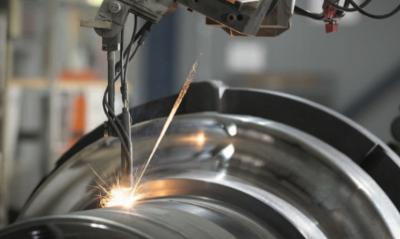LaserBond has been using thermal coating techniques to produce hard-wearing components and products for the mining, power generation, manufacturing and agriculture industries since 1992.
But a downturn in the mining industry is helping to fuel demand for its products as companies look to maximise productivity.
LaserBond Chairman Allan Morton said the company’s laser-applied coatings typically tripled the life of a product.
“This is effectively 3D printing using industrial robots and industrial lasers to add material to existing substrates to create better performing products,” he said.
“The economic benefit is not so much that the components are lasting longer, it’s that you don’t have to shut the system down to change components so they’re getting longer cycles out and that has ramifications in the workplace health and safety area as well.
“When everything was going fine in our boom times people said ‘we will not pay that’ because even though we might have four times the life we might be double the price but now companies are looking at costs and the cost of downtime overwhelms any incremental cost of a higher-performing component that we supply.
“We’ve said our day will come at the bottom of the cycle.”
Founded in New South Wales, the company has about 65 staff and has had a plant in South Australia since 2013.
It has recently formed a research collaboration with the University of South Australia’s Future Industries Institute and is establishing a new “laser cell” in Adelaide featuring a 16kW laser, which it hopes to have up and running in September.
“We know that we make a 60 per cent energy saving, we get higher efficiency and we get less waste with these new lasers. We currently have the three most powerful lasers in Australia in this industry and the one we’re buying will be twice as big again – it will be the highest power laser beam used for laser cladding in the southern hemisphere.
LaserBond predominantly manufactures for the mining industry and exports about 80 per cent of its products to countries including Chile, Mongolia and South Africa.
Products are typically made from steel and then applied with materials such as nickel alloys, tungsten, titanium carbides and ceramics. Manufactured items include mining picks, furnace doors and ‘down the hole’ hammers.
“Basically any metal component that wears we can apply a surface to make it last longer for new parts as well as we can make an old part with new surfaces that are better than new,” Morton said.
The company expects the new laser to allow it to double production.
“We’re able to deposit material quicker than we currently do and also it’s all about energy.
“We can put a certain amount of composite material on a part, we want to be able to increase that speed to enable us to be more cost effective for our customers.”
LaserBond Founder and Executive Director Greg Hooper is recognised as a world-leader in the field. He has moved from Sydney to Adelaide to play a key role in the Research & Development side of the business and the collaboration with UniSA at Mawson Lakes, which is just a five-minute drive from the company’s SA base at Cavan.
“There is a lot of opportunity in a lot of different industries. I’ve been working on materials and depositing those materials better and quicker so we can be more competitive,” he said.
“We envisage that South Australia has the focus for the R&D and it will become our product manufacturing division, which will be our biggest division over time.
“It appears to me that the time is changing with regard to the collaboration of universities with private industry and it’s very enlightening.”





